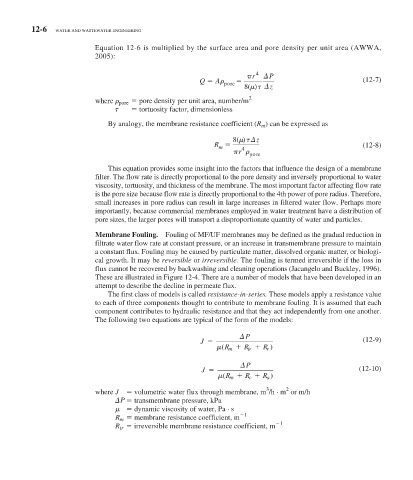Page 489 - Water and wastewater engineering
P. 489
12-6 WATER AND WASTEWATER ENGINEERING
Equation 12-6 is multiplied by the surface area and pore density per unit area (AWWA,
2005):
r 4 P
(12-7)
Q A pore
)
8( z
2
where pore pore density per unit area, number/m
tortuosity factor, dimensionless
By analogy, the membrane resistance coefficient ( R m ) can be expressed as
z
R 8() (12-8)
m
4
r pore
This equation provides some insight into the factors that influence the design of a membrane
filter. The flow rate is directly proportional to the pore density and inversely proportional to water
viscosity, tortuosity, and thickness of the membrane. The most important factor affecting flow rate
is the pore size because flow rate is directly proportional to the 4th power of pore radius. Therefore,
small increases in pore radius can result in large increases in filtered water flow. Perhaps more
importantly, because commercial membranes employed in water treatment have a distribution of
pore sizes, the larger pores will transport a disproportionate quantity of water and particles.
Membrane Fouling. Fouling of MF/UF membranes may be defined as the gradual reduction in
filtrate water flow rate at constant pressure, or an increase in transmembrane pressure to maintain
a constant flux. Fouling may be caused by particulate matter, dissolved organic matter, or biologi-
cal growth. It may be reversible or irreversible. The fouling is termed irreversible if the loss in
flux cannot be recovered by backwashing and cleaning operations (Jacangelo and Buckley, 1996).
These are illustrated in Figure 12-4 . There are a number of models that have been developed in an
attempt to describe the decline in permeate flux.
The first class of models is called resistance-in-series. These models apply a resistance value
to each of three components thought to contribute to membrane fouling. It is assumed that each
component contributes to hydraulic resistance and that they act independently from one another.
The following two equations are typical of the form of the models:
P
J (12-9)
( R m R ir R r )
P
J (12-10)
( R m R c R a )
2
3
where J volumetric water flux through membrane, m /h · m or m/h
P transmembrane pressure, kPa
dynamic viscosity of water, Pa · s
1
R m membrane resistance coefficient, m
1
R ir irreversible membrane resistance coefficient, m

